Cellphedia, a thesis project at the Interactive Telecommunications Program at NYU, is a user-generated encyclopedia composed of text message Q&A from cell phones – a kind of mobile, hyper-abbreviated Wikipedia. But unlike Wikipedia, Cellphedia entries are not open to editing by the community, at least not yet. Inspired by Dodgeball, a popular friend-tracking service, Cellphedia suggests something more along the lines of a massive, multi-user trivia game than a serious knowledge resource. It’s the kind of street research that is becoming more common. Answers on impulse. The web overlayed on the physical world.
Category Archives: Microlit
mobile web initiative
The World Wide Web Consortium (W3C), the main standards-setting body for the networked world we live and breathe, recently launched the Mobile Web Initiative. From the press release:
“Many of today’s mobile devices already feature Web browsers and the demand for mobile devices continues to grow. Despite these trends, browsing the Web from a mobile device — for example, to find product information, consult timetables, check email, transfer money — has not become as convenient as expected. Users often find that their favorite Web sites are not accessible or not as easy to use on their mobile phone as on their desktop computer. Content providers have difficulties building Web sites that work well on all types and configurations of mobile phones offering Web access.”
The web is moving further and further from being exclusively a desktop system. What began essentially as a set of interlinked brochures, to be read sitting down, has evolved into a dynamic, social multimedia space, increasingly connected to the world around us. I often think of the history of industrialization as a story of estrangement from the physical world. Cities swell, smog billows and the haze of electric light washes out the stars. Mass media forms naturally emerge from the concentration of industry – economies of scale that favor homogeneity, the sweeping gesture. At first, the new media seem to take this estrangement further, confining us to “virtual” spaces. But quite to the contrary, the web is taking us back into the world, not out of it. Even something as simple as Google Maps suggests this return. But to become fully unmoored from our desks, standards have to be set in place to ensure that the web is readable in smaller formats, and that we have faster, more reliable access when we’re on the move. Plus, the devices need to emerge that offer the convenience of a cell phone with the power of a notebook computer. The future of personal computing lies more with cell phones (see the new Sidekick II), iPods and Play Station Portable than with the latest desktop from Dell or Apple.
wireless fairy tales
Kids in Denmark may soon be reading Hans Christian Anderson on their cell phones. To celebrate the writer’s bicentennial, a Danish company is releasing an interactive comic book series designed specially for the tiny screen.
(via textually.org)
viral video lit
Faced with declining coverage of books in newspapers and magazines, writers are constantly looking for new ways to promote their work on the web. Literary blogs have done a lot to fill in the gaps left by print, covering lesser-known authors and titles translated from foreign languages, and even revisiting older works. And since many lit bloggers are writers themselves, the blogs serve as a virtual salon where writers and intellectuals come to spar about literature, recommend books, and share their own work. Cory Doctorow offers free, cc-licensed downloads of his novels, attracting readers, generating buzz, and bolstering sales of his books in print. Others are sneakier, deploying anonymous 5-star reviews under their own titles to boost sales on Amazon.
The latest, and probably most expensive, trick is video lit, or book shorts – brief little films (like movie trailers or music videos, but for books) designed to be spread virally through email, blog shout outs, and links, just like the digital tidbits – video clips, images, sites, articles – we stumble upon and circulate daily among friends and family. If people like what they see, they can buy the book (a convenient link to Amazon or Barnes & Noble is provided).
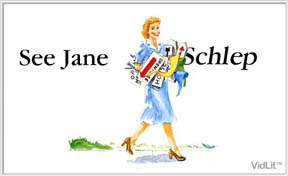 It sounds a bit cock-eyed to advertise books as though they were movies, but proponents of the form say it can get results. There’s a piece in Wired that profiles some of the writers who have experimented with the form, and the little production houses that help them do it. The most frequently cited example is a Flash-animated encapsulation of “Yiddish With Dick and Jane,” a borscht-belt-infused pastiche of the iconic 1950s children’s reading primers. Not too long ago, the 2:45-minute film, produced by a company called Vidlit, was getting passed around incessantly on the web, while at the same time, the physical book flew like hot cakes off the shelves, going on to sell over 150,000 copies. Whether the two are related is hard to say. The book was pretty heavily promoted in stores as a no-brain-required gift item. But Vidlit touts this as a coup of viral advertising.
It sounds a bit cock-eyed to advertise books as though they were movies, but proponents of the form say it can get results. There’s a piece in Wired that profiles some of the writers who have experimented with the form, and the little production houses that help them do it. The most frequently cited example is a Flash-animated encapsulation of “Yiddish With Dick and Jane,” a borscht-belt-infused pastiche of the iconic 1950s children’s reading primers. Not too long ago, the 2:45-minute film, produced by a company called Vidlit, was getting passed around incessantly on the web, while at the same time, the physical book flew like hot cakes off the shelves, going on to sell over 150,000 copies. Whether the two are related is hard to say. The book was pretty heavily promoted in stores as a no-brain-required gift item. But Vidlit touts this as a coup of viral advertising.
BookShorts, a Canadian company, produces full live action films for its titles. I watched the book short for Susan Swan’s novel “What Casanova Told Me” and was not terribly impressed. It comes off like a preview for a TV movie adaption of a trashy book. But the Dick and Jane example, silly as it is, suggests how clever design and a quick one-two punch can get you a lot of mileage on the web. If people like the idea (and clearly they did), and if the film possesses a kind of must-see quality (the visual equivalent of a good one-liner, a zinger), then people might feel compelled to shuffle it voluntarily through the web. I could see this perhaps working for a political tract or manifesto, or for a religious text – something that is compulsive and seems to contain the seeds of larger truths or revelations. Imagine if this piece were connected to a book (click “Knife Party,” then again in new window, then watch “What Barry Says” by hitting “click here” at the bottom). Breathtaking visuals and a compelling political premise combine to whet the appetite for further reading.
reading on your PSP
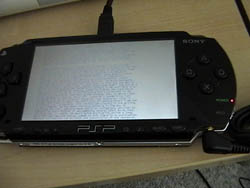 Not surprisingly, folks have already figured out how to read books on the new Sony PSP (PlayStation Portable). The hack is pretty basic – you just turn pages into jpeg images and dump them into the picture folder. The snapshots stack up as a book. Packet Switched Press has even published a short story – a sci-fi piece called “Moving Pictures” – formatted specially for the device (you’re supposed to rotate it 90 degrees to view vertically) (thanks, Boing Boing).
Not surprisingly, folks have already figured out how to read books on the new Sony PSP (PlayStation Portable). The hack is pretty basic – you just turn pages into jpeg images and dump them into the picture folder. The snapshots stack up as a book. Packet Switched Press has even published a short story – a sci-fi piece called “Moving Pictures” – formatted specially for the device (you’re supposed to rotate it 90 degrees to view vertically) (thanks, Boing Boing).
The PSP marks another step toward an ideal portable media device (see the ideal pod), the ebook hack being only one of many tricks to cram in more content options (Wired article for more). The Packet Switch Press story suggests that on the tiny screen, 90 degrees can be all that separates a widescreen movie from an electronic paperback – there’s no “this side up.” The big problem with the PSP is its proprietary file format, laughably named Universal Media Disc (UMD). To watch a movie on your PSP, you have to buy the UMD-formatted edition, even if you already own the DVD. This will ultimately inhibit the development of interesting new works for the tiny screen, clever hacks notwithstanding.
the ideal pod
Yesterday, Boing Boing linked to five enticing design fantasies of future Apple products by design firm Pentagram:

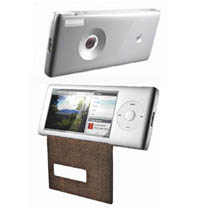
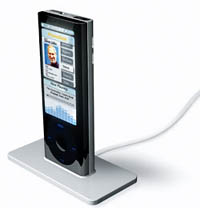
If Apple is to stay at the head of the pack, then the answer is to combine the wireless iPod, the vPod, and the iPhone into one ideal pod. In addition to having access to all your music, video and photos, you can surf the web, take movies and pictures, play video games, talk on the phone, watch films in letterbox format, and read various kinds of books – anything from novels, to newspapers, to websites, to manga or comics. IPod’s signature scroll wheel would work wonderfully with text, paging through horizontally and preserving some semblance of a coherent page or panel, like the International Herald Tribune does on its elegant website. It could have a little stylus tucked away like tweezers in a Swiss Army knife, and a virtual keyboard that projects on surfaces. A month ago, I wrote about the need for a “paperback ebook” – a pan-media everything-pod, something that does for portable media what paperbacks did for books. Perhaps Apple will be the first to venture such a device.
Laptops are on a collision course with cell phones. Eventually they will converge in a single ideal device. Specialized devices like snapshot digital cameras, iPods, Game Boys, and ebook readers are exciting while they are relatively new, but they are ultimately impractical. Nobody wants a device that just does one thing. Everyday, you have to pack your pockets with various gadgets – you begin to feel like a slave to the so-called convenience of these things. Phones and computers, on the other hand, are indispensable, and can theoretically encompass all of these specialized devices. So it seems like just a matter of time until everything is packed into one ideal pod.
polish poet pens for phone
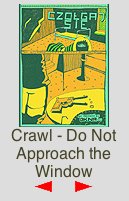
![]() The Digital Museum of Modern Art, a virtual exhibition space, is featuring “Czolgaj Sie” (“Crawl”), verses by Polish poet Marcin Swietlicki, illustrated by fellow countryman Cezary Ostrowski. The poem is exhibited on the museum’s website, and has also been optimized for reading on a mobile phone.
The Digital Museum of Modern Art, a virtual exhibition space, is featuring “Czolgaj Sie” (“Crawl”), verses by Polish poet Marcin Swietlicki, illustrated by fellow countryman Cezary Ostrowski. The poem is exhibited on the museum’s website, and has also been optimized for reading on a mobile phone.
I’m not crazy about the poem, but it’s an intriguing experiment. Is there a Flash plugin for phones so one can view dynamic text (like this)?
(via textually)
novels on your phone

There was a great AP article yesterday on the recent boom in cell phone novels and serials in Japan. The top and bottom images here are pulled from “Bunko Yomihodai,” or “All You Can Read Paperbacks” – a popular microlit site with over 50,000 subscribers, offering 150 titles written or adapted specially for reading on phones.
“In the latest versions, cell-phone novels are downloaded in short installments and run on handsets as Java-based applications. You’re free to browse as though you’re in a bookstore, whether you’re at home, in your office or on a commuter train. A whole library can be tucked away in your cell phone — a gadget you carry around anyway.”
True. Right now, the cell phone is the ultimate indispensable gadget. It’s with us practically all the time. No wonder it’s the first place that electronic books are gaining a foothold.
And the content is varied…
“Surprisingly, people are using cell-phone books to catch up on classics they never finished reading. And people are perusing sex manuals and other books they’re too embarrassed to be caught reading or buying. More common is keeping an electronic dictionary in your phone in case a need arises.”
Microlit hasn’t really taken off here in the States, though there are a few signs that suggest a gradual movement in this direction. There was a bit of buzz about a month ago when Random House acquired a significant minority stake in wireless applications developer VOCEL. And more people seem to be using their phones and PDAs for reading – everything from websurfing, to RSS feeds, to downloaded books (or even raw text files of public domain literature – I tried this on my iPod with this fun hack). But we have yet to see any kind of full-blown lit phenomenon.
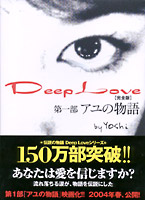 The breakthrough work in Japan was a serial called “Deep Love,” the story of a teenage prostitute in Tokyo. It became so popular that it was published as an actual book, and spun off into a TV series, a manga (comics), and a movie. Now the author, named simply Yoshi, is trying his hand at thrillers. From the article:
The breakthrough work in Japan was a serial called “Deep Love,” the story of a teenage prostitute in Tokyo. It became so popular that it was published as an actual book, and spun off into a TV series, a manga (comics), and a movie. Now the author, named simply Yoshi, is trying his hand at thrillers. From the article:“Another work by Yoshi, a horror mystery, has a cell-phone Web link that readers click. One pulls up a video clip of a bleeding face; another shows a letter that tells people to go on living.
“Yoshi, a former prep-school instructor who sees his readers as “a community,” reads the dozens of e-mail messages teenage fans send him daily and uses their material for story ideas.
“He also knows immediately when readers are getting bored and changes the plot when access tallies start dipping for his stories.
“‘It’s like playing live music at a club,'” he said. ‘You know right away if the audience isn’t responding, and you can change what you’re doing right then and there.'”
Remember that Dickens often wrote in this way. Perhaps we are witnessing the return of serialized novels.
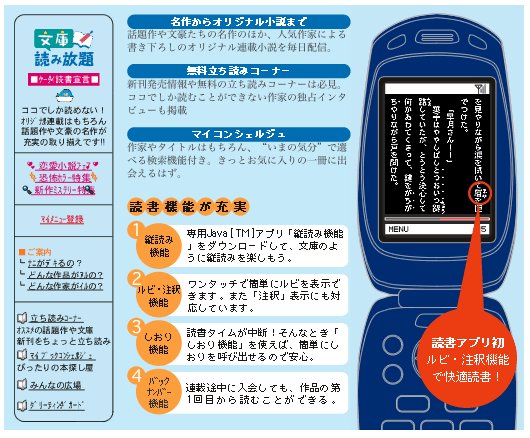
l.i. library lends ipods
Boing Boing points to a library in Long Island that has recently started lending mp3 audio books on iPod shuffles, even throwing in casette adapters and FM transmitters for listening in the car. The library claims that they are saving a lot of money in the long run, since mp3 audio books cost significantly less than books on cd.
>>Wired story
paperback ebook
 Booktopia, a Korean ebook developer, is introducing a 29-title series for mobile users based on popular movie scenarios (article), including the recent Cannes hit Old Boy (thanks, textually.org). The books act as supplements to the films, with omitted material and glimpses behind-the-scenes, sort of like special features on a DVD (though it appears that they will be text-only). They also seem to riff on that weird tie-in genre of books adapted from the screen (I’ve always wondered who reads those books..).
Booktopia, a Korean ebook developer, is introducing a 29-title series for mobile users based on popular movie scenarios (article), including the recent Cannes hit Old Boy (thanks, textually.org). The books act as supplements to the films, with omitted material and glimpses behind-the-scenes, sort of like special features on a DVD (though it appears that they will be text-only). They also seem to riff on that weird tie-in genre of books adapted from the screen (I’ve always wondered who reads those books..).
So are phones the electronic book in embryo? If you are looking for innovation in form, what’s happening on cell phones and mobile devices is far more interesting than what you’ll find in the area of conventional “ebooks,” which generally are the kind of pdf nightmare Dan decribes in his post yesterday. But so far, these kinds of mobile books, or mbooks, are to literature what ring tones are to music. The cell phone has become a kind of cud for the distracted brain to chew – I can’t count how many people I see on the subway or waiting in lines simply fiddling with their phone settings. What seems to be developing on cell phones is a new kind of ephemera descended from the pamphlet, flyer, or broadsheet, which will be tightly interwoven with advertising (these Korean movie tie-ins do leg work for the actual films, just as the new 24 spinoff offered on Verizon plugs the Fox television series). But what about actual books? Serious reading to counterbalance all the fluff. Portable devices like phones and palm pilots lend themselves to the serial model. Their diminutive size makes them better suited to smaller chunks of material, and their access to networks allows them to constantly grab new chunks. But I don’t see why quality has to be sacrificed. Perhaps, with time, the tradition of serialized narrative will be reinvented in meaningful ways. Many of Dickens’s novels were published and written serially, and he was able to modulate the course of his writing according to reader response and sales. Digital content delivery over cell phones and the web could employ the same fluidity, delivering the book as it is becoming, and creating whole communities of readers on the web (see earlier post elegant map hack). An interesting prospect for writers as well as readers.
These literary experiments on the tiny screen are probably not trivial, even though the content may be. They seem to be saying “hurry up” to our more sophisticated but unwieldy reading devices like laptops and tablets. We need a kind of paperback ebook, in between a laptop and a smartphone – cheap and easy to tote. If I can comfortably read on this device in a crowded subway, then we might finally have something as handy as a paper book, conducive to any kind of content, with all the affordances of computers and the web. And ideally… I can write on it with a stylus, or on a keyboard that it projects on a tabletop, and I can dock it at a more powerful workstation in my office. I can plug in headphones or speakers and explore my music library, or surf satellite radio. I can watch a film that I made, or one that I downloaded, or I can flip through my photo album. If I’m lost, I can get a map with pictures of the place I’m trying to find. And at night, I can curl up with it in bed, reading by the light of its built-in candle. I may even have glasses I can plug in and read the book without hands, or look at images in 3-D like on a stereopticon. (Kim, I think I may have my fantasy ebook) Nothing could ever truly replace paper books for me, but a pan-media tablet – an everything device – might just become my everyday companion.
